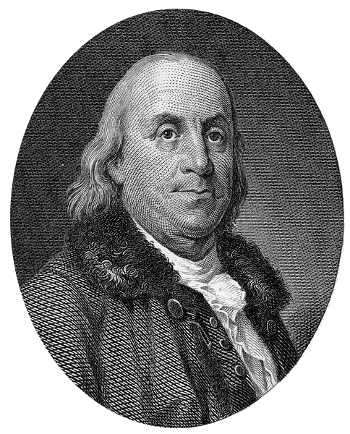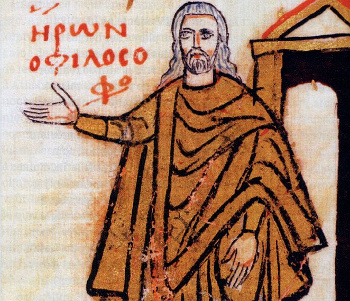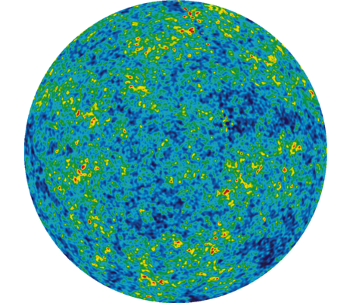Infinite c
January 9, 2017
Benjamin Franklin would likely have been among the first
Presidents of the United States were it not for his advanced age at the
birth of the nation. Franklin is famous for
the phrase, "...in this world nothing can be said to be certain, except
death and
taxes," that he included in a letter in 1789. The phrase appears to have originated before Franklin, in 1716.

Benjamin Franklin (1706-1790) is featured on the United States hundred-dollar bill.
Aside from his many experiments on electricity, Franklin is known in science as an early advocate of the wave theory of light. It was many years later when Young's 1803 double-slit experiment provided convincing evidence for the theory.
(Via Wikimedia Commons.)
Science has given us a few certainties beyond death and taxes. We can be fairly certain that no
chemical element will be discovered between
hydrogen and
helium. Some
physical quantities are thought to be so immutable that we've elevated them to the status of
constants, and their values are tabulated by the
Task Group on Fundamental Constants of the
Committee on Data for Science and Technology. The
US National Institute of Standards and Technology (NIST) list 335 such constants on its web site.[1-2]
One of these constants is the
speed of light in
vacuum, symbolized by
c, which has an exact value of 299,792,458
meters per second. The reason for the exactness of this value is that it's used to define the
meter. In the past, the meter, a
physical object kept at the
International Bureau of Weights and Measures near
Paris, was a constant, so the speed of light was derived from the meter. As technology advanced, we found it more appropriate to define the speed of light as a constant, and this was done in 1983. The
second is defined as the duration of 9,192,631,770
periods of the
radiation from a certain electron transition in
cesium-133.
In casual
calculation, most
physicists will use 300,000,000 meters/sec for the speed of light, since it's easy to
remember, and it's just 0.07% larger than the actual value. The speed of light is so large that
humans perceive its speed to be
infinite. The
ancient Greek philosophers Euclid and
Ptolemy thought that the process of
vision involved
light emanating from the
eyes and
reflecting back to the observer. From this idea,
Hero of Alexandria reasoned that the speed of light must be infinite, since we instantly see distant objects, such as
stars, when we open our eyes.

Hero of Alexandria, from the Codex of Saint Gregory Nazianzenos, a Greek manuscript of the 9th century.
Hero is known for many things, including Hero's formula giving the area of a triangle from its sides.
(Via Wikimedia Commons.)
The first experiment designed to measure the speed of light was performed by
Galileo in 1638. The experiment was done using
signal lanterns separated by a large distance, and he concluded that the speed was either very rapid or instantaneous. The round-trip transit time of light over a
mile's distance is just 10.73
microseconds, which is too short an interval for humans to notice.
The
Danish astronomer,
Ole Rømer, was the first to give an actual value for the speed of light. In 1676, Rømer used the period of
Jupiter's moon,
Io, as a
clock to find a value of 220,000,000 meters/sec, which is about 75% of the established value. A more accurate
astronomical measurement was made in 1729 by
English astronomer,
James Bradley, who used his discovery of the
aberration of light to calculate its speed to within 1.5% of its established value.
Does it really matter that the speed of light is very large but not infinite?
life might not exist in a
universe with an infinite speed of light. Life is the culmination of a long chain of
non-equilibrium processes, and an infinite speed of light would force the universe into a very
equilibrium state. This wouldn't be the
gray goo of a runaway
horde of
self-replicating nanobots, but rather a hot white goo of undifferentiated
nuclear matter.
While
laboratory measurements have been giving us a fairly constant value for the speed of light, we've only been doing these for a very short span of time compared with the
age of the universe. Could the speed of light have been different in the distant past? Measurements of the
fine structure constant, a constant that's important to the stability of
atoms, show that its rate of change, if it does change at all, is extremely small, of the order of (-1.6±2.3)x10
-17 parts per year.[3] The fine structure constant can be expressed in terms of other
fundamental constants, including the speed of light.
A recent astronomical measurement of 120 ultra-compact
radio sources gave an estimate of the speed of light when the universe was just 3.80 billion years old; that is, about ten billion years ago. That estimate, 2.995(±0.235)x10
5 km/s, is consistent with the laboratory value of 299,792,458 meter/second.[4]
According to current
theory, the universe that we see is the one that exists after a
cosmic inflation, a period up to 10
-32 seconds after the
Big Bang in which the universe went through a stage of rapid expansion that produced its present
isotropic structure. The early universe was a very
energetic and strange place. Is there an alternative to inflation that gives us our present universe?
That was the question that
Niayesh Afshordi of the
Perimeter Institute for Theoretical Physics (Waterloo, Ontario, Canada) and
João Magueijo of
Imperial College (London, United Kingdom) addressed in a recent
paper.[5-7] They propose an alternative to inflation based on an infinite speed of light in that early, energetic universe. An infinite speed of light at that time would allow evolution of the isotropic universe that we see today.
Papers on
spacetime cosmology are
mathematically dense (see figure), but the essential idea of the paper, that an initially infinite speed of light would "
thermalize" the Big Bang to produce a
homogeneous universe, is easy to understand. At infinite speed,
radiation would reach into every portion of the universe and equalize any
temperature differences.

Having published a recent article on math phobia in physics (Math Anxiety, November 21, 2016), I thought it would be interesting to share this equation, describing a power spectrum, from Afshordi and Magueijo's paper. (Equation 51 of ref. 6.)[6)]
Paper
co-author, João Magueijo has being developing such variable speed of light theories for two
decades as an alternative to inflation.[9] Inflation as the reigning
paradigm that explains of the origin of
galaxies is deeply entrenched, and it will be hard to supplant without sufficient evidence.[7] One aspect of Magueijo's theory is that light in the early universe
propagated much faster than
gravity.[7]
Fortunately, this
theory is testable. It predicts a specific pattern in the
density variations of the early universe that leads to a particular value for a
parameter called the
spectral index. The predicted spectral index is 0.96478, which is close to the present measured value of 0.968, as derived from
data of the
cosmic microwave background radiation.[7-8]

A map of the cosmic microwave background, a radiation relict of the Big Bang.
In this map of half the sky, the average temperature is 2.725 kelvin, and the mapped variation is just 400 microkelvin.
(NASA/WMAP Science Team image, via Wikimedia Commons.)
References:
- NIST Reference on Constants, Units, and Uncertainty, Fundamental Constants Data Center, NIST Physical Measurement Laboratory.
- Fundamental Physical Constants, Complete Listing, NIST (text file).
- T. Rosenband, D. B. Hume, P. O. Schmidt†, C. W. Chou, A. Brusch, L. Lorini, W. H. Oskay, R. E. Drullinger, T. M. Fortier, J. E. Stalnaker, S. A. Diddams, W. C. Swann, N. R. Newbury, W. M. Itano, D. J. Wineland, and J. C. Bergquist, "Frequency Ratio of Al+ and Hg+ Single-Ion Optical Clocks; Metrology at the 17th Decimal Place," Science, vol. 319, no.5871 (March 28, 2008), pp. 1808-1812, DOI: 10.1126/science.1154622.
- Shuo Cao, Marek Biesiada, John Jackson, Xiaogang Zheng, and Zong-Hong Zhu, "Measuring the speed of light with ultra-compact radio quasars," arXiv, September 28, 2016.
- Niayesh Afshordi, João Magueijo, "The critical geometry of a thermal big bang," Phys. Rev. D, vol. 94, no. 10, Article No. 101301(R), Rapid Communication (November 18, 2016), DOI:https://doi.org/10.1103/PhysRevD.94.101301.
- Niayesh Afshordi, João Magueijo, "The critical geometry of a thermal big bang," arXiv version of ref. 5, November 8, 2016.
- Ian Sample, "Theory challenging Einstein's view on speed of light could soon be tested, The Guardian (UK), November 28, 2016.
- Akshat Rathi, "Physicists plan to test a new theory about the speed of light to explain what Einstein’s theory can't," Quartz, November 27, 2016.
- Joseph Dussault, "Einstein's speed of light theory tested: Did he get it wrong?" Christian Science Monitor, November 28, 2016.
Permanent Link to this article
Linked Keywords: Benjamin Franklin; Presidents of the United States; United States Declaration of Independence; birth of the nation; death and taxes (idiom); death; taxes; United States hundred-dollar bill; experiment; electricity; science; wave theory of light; Thomas Young (scientist); double-slit experiment; Wikimedia Commons; chemical element; hydrogen; helium; physical quantity; physical constant; Task Group on Fundamental Constants; Committee on Data for Science and Technology; US National Institute of Standards and Technology (NIST); speed of light; vacuum; meters per second; meter; international prototype meter; International Bureau of Weights and Measures; Paris; second; frequency; period; cesium standard; hyperfine electron transition; cesium-133; calculation; physicist; long-term memory; remember; human; infinity; infinite; ancient Greek philosopher; Euclid; Ptolemy; visual perception; vision; light; eye; reflection; reflecting; Heron of Alexandria; Hero of Alexandria; star; Codex; Saint Gregory Nazianzenos; Greek language; manuscript; 9th century; Heron's formula; Hero's formula; Galileo Galilei; signal lantern; mile; microsecond; Denmark; Danish; astronomer; Ole Rømer; Jupiter; natural satellite; moon; Io; clock; astronomy; astronomical; English; James Bradley; aberration of light; life; universe; non-equilibrium thermodynamics; non-equilibrium process; thermal equilibrium; equilibrium state; gray goo; horde; self-replication; self-replicating; nanorobotics; nanobots; nuclear matter; laboratory; age of the universe; fine structure constant; atom; parts per year; fundamental constant; astronomical radio source; theory; cosmic inflation; Big Bang; isotropy; isotropic structure; energy; energetic; Niayesh Afshordi; Perimeter Institute for Theoretical Physics (Waterloo, Ontario, Canada); João Magueijo; Imperial College (London, United Kingdom); scientific literature; paper; spacetime; cosmology; mathematics; mathematical; number density; dense; thermalize; homogeneous; temperature; phobia; physics; equation; power spectrum; co-author; decade; paradigm; galaxy; galaxies; propagation of light; gravitation; gravity; falsifiability; testable; density; parameter; spectral index; data; cosmic microwave background radiation; relict; average; kelvin; NASA; Wilkinson Microwave Anisotropy Probe; WMAP Science Team.